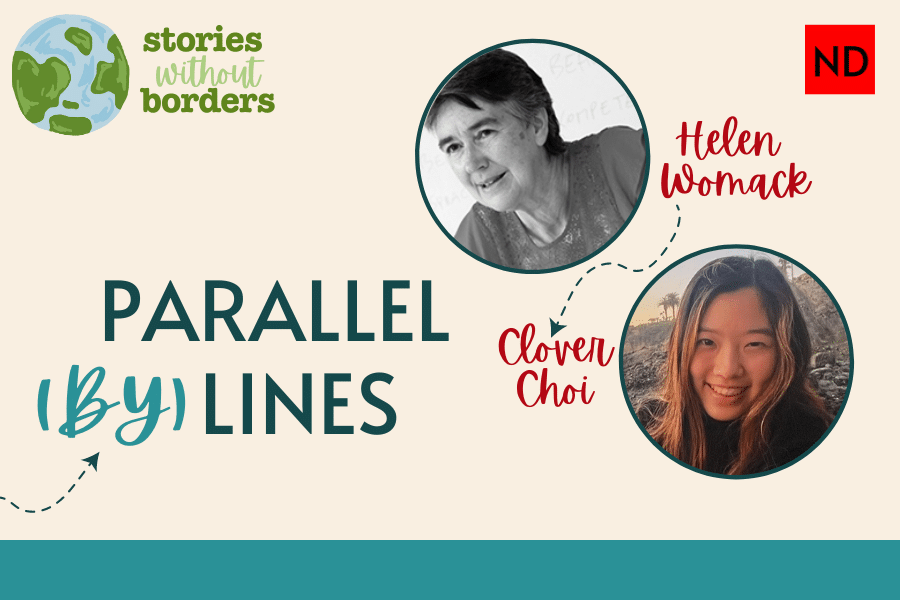
by Nelson Graves | 25 Sep 2023 | History, Journalism, Media Literacy
Getting stories right used to be more important than getting the scoop. Maybe it’s time to return to careful, skeptical and dispassionate reporting. Four jockeys on horseback. (Credit: Jupiterimages) This article was produced exclusively for News Decoder’s...

by Helen Womack | 12 Sep 2023 | Education, Educators' Catalog, Journalism, Media Literacy, Russia
A blank page confronts every writer on deadline. Turning that empty space into an article someone might read takes more than simply hitting keys on a keyboard. Two images of a woman at a typewriter trying to find an idea. Photo illustration by News Decoder. This...
ND correspondent Helen Womack takes us through her process of going from a blank page to a published article in this piece on confronting writer’s block. How can we help students find their voice?
Exercise: Read the article with your class, then have students brainstorm pitches that they can submit to News Decoder. How might their initial ideas be transformed into a publishable piece? Consider: global/local relevance of pitches, at least two sources to interview to investigate the topic, students’ unique angle on the topic. Students should then submit a pitch for an opportunity to work with our editors to be published on our global news site.
For further tips on interviewing and drafting, direct students to our asynchronous E-Learning courses. If you’re not a member of our school network, contact us to learn more about these members-only resources.

by Joyce Yang | 8 Aug 2023 | Education, Media Literacy, Personal Reflections
Living in a globalized world means appreciating the nuance of diverse perspectives and shared experiences. Global Citizenship Education (Canva). The field of education loves its buzzphrases. Standards-based grading. Project-based learning. Media literacy education. ...

by Norma Hilton | 3 Aug 2023 | Educators' Catalog, Journalism, Media Literacy
Making sure that information is true isn’t easy. Our correspondent takes you through the arduous process of fact-checking a news story. Illustration by Ana Schwartz for News Decoder When I first started out in journalism as a 17-year-old, I had never heard of...
Correspondent Norma Hilton models the process of fact-checking in this important article for students and adults alike. In a world inundated with instantaneous information at our fingertips, knowing how to distinguish fact from fiction is ever-critical.
Exercise: After reading the article, have students dissect the fact-checking process modeled in the text. Prompt a class discussion on what the process looks like in practice, step-by-step. Did anything about the process surprise them? Then, in pairs, students should fact-check a short news text (either one they’ve selected or one you provide to them). Which sources should they examine to confirm that the text is credible?

by Paul Spencer Sochaczewski | 20 Jul 2023 | History, Malaysia, Media Literacy, Science
What one correspondent learned by writing an “enhanced biography” of a little-known 19th-century teenager from Borneo. The 15-year-old Malay, known to history only as “Ali” is featured on this graffiti signboard in Ternate, Indonesia. The artist refers to Wallace’s...

by Marcy Burstiner | 4 Jul 2023 | Journalism, Media Literacy
It can be difficult to tell the difference between fact and opinion. And some things we consider true may not be true to all people. (Illustration by News Decoder) At News Decoder we are all about fact-based journalism. That means that the information in a news story...

by Marcy Burstiner | 28 Jun 2023 | Journalism, Media Literacy
We teach teens to see the world through a journalistic lens. But what does that mean? And how can that help to teach global awareness and media literacy? Two journalists reporting from a war zone. (Credit: South_agency from Getty Images Signature) Journalists look for...

by Marcy Burstiner | 27 Jun 2023 | Journalism, Media Literacy, News Decoder Updates, Parallel (By)Lines
At News Decoder everything we do is designed to foster global awareness and make us all better global citizens. Problems cross borders. The solutions connect us. We can all be better global citizens by seeing what is happening around us in relation to what happens...

by Skyler Kelley Duval | 20 Apr 2023 | Educators' Catalog, La Jolla Country Day School, Media Literacy, Politics, United States, Youth Voices
When the business model for news corporations depends on blurring the lines between fact and opinion, how can we move from partisanship to problem solving? Photo illustration by News Decoder. In 2017, the political landscape collectively scoffed at Donald...
With news media inundating our feeds with content, youth guest author Skyler Kelley Duval dissects the blurred lines between fact and fiction. Central to being able to responsibly consume media is investment in critical thinking and media literacy education in schools. Are your students media literate?
Exercise: Read the article with your class, then introduce the CRAAP test to your students as a tool to evaluate media sources. The CRAAP test assesses sources for Currency, Relevancy, Authority, Accuracy and Purpose — with a goal of determining trustworthiness. You can find an example of the CRAAP test here. Consider analyzing a media source together as a class using the test.

by Marcy Burstiner | 17 Apr 2023 | Journalism, Media Literacy
We ask young people what they want to be in life. But do we allow them to become the best person they can be? This can’t be done in a single class lesson. Illustration by News Decoder What kind of learning do we seek? That’s what Veronica Boix Mansilla asked an...










